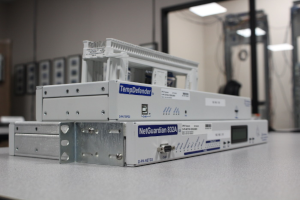Check out our White Paper Series!
A complete library of helpful advice and survival guides for every aspect of system monitoring and control.
1-800-693-0351
Have a specific question? Ask our team of expert engineers and get a specific answer!
Sign up for the next DPS Factory Training!

Whether you're new to our equipment or you've used it for years, DPS factory training is the best way to get more from your monitoring.
Reserve Your Seat TodayJust about every network manager is at least aware of SNMP. You've probably got devices in your network right now that use SNMP for machine-to-machine communication. In all likelihood, you're using them already.
But here's the hard truth...
Just using SNMP isn't enough. If you're not using SNMP the right way, you're not getting a good return on your investment. In fact, you could be leaving thousands - or even millions - of dollars on the table due to avoidable inefficiencies and blind spots in your monitoring.
Let's dive into the real-world ROI of SNMP - and how you can unlock its full potential with the right architecture and tools.

Let's start with the biggest misconception in the room:
"I've got SNMP. I've done everything I need to do."
SNMP is just a tool, not a complete solution. It's a protocol, but also a bare-bones one when you don't implement it using a planned strategy. And using it incorrectly can cause massive issues down the line, such as:
As a direct result, you end up wasting labor, responding late to critical issues, and scrambling during outages. That's isn't just frustrating. It's also expensive.
Let's break down where traditional SNMP implementations go wrong, so you can avoid the same fate.
Basic SNMP managers don't filter alarms effectively. Every Trap - no matter how small - gets dumped onto your screen. When real emergencies hit, they get buried in noise and you miss what matters most.
When a tech clicks "acknowledge," most SNMP managers treat it as resolved - even if it isn't. That faulty battery? That offline radio? Still broken. But the system acts like everything's fine.
Did someone see the alarm? Did they take action? Did they ignore it? If your SNMP system isn't logging user activity, you're operating without enough oversight.
You get a Trap. But what failed? Where did it fail? What device is it tied to? Most off-the-shelf SNMP software doesn't give you any helpful context. They just output raw messages that require constant guesswork.
Now let's take a look at the positives SNMP has to offer. After all, there's no way it would have become so popular if it didn't have some virtues.
Consider what "doing SNMP right" actually looks like. It should involve:
SNMP is an IP protocol that uses your existing LAN/WAN network.
SNMP is an open standard. You can monitor a NetGuardian RTU, a Cisco switch, a battery plant, or anything else. With the right MIBs, it all works together. You can start at one site and scale to hundreds without a forklift upgrade.
Temperature? Voltage? Door sensors? SNMP can carry data related to analog values, discrete on/off sensors, and more. Whether you're in telecom, utilities, or transportation, it adapts to your needs.
No more waiting for the next polling cycle. SNMP Traps alert you the moment something breaks. That's the real-time response you need for real-world disasters.
Of course, polling still has the advantage of helping you detect failures promptly, which is something you can still do with the right SNMP manager and SNMP "GET" messages running on a cycle.
SNMP alone won't inherently get the job done for you. The protocol is solid, but the problem lies in the implementation. If you slap together an SNMP manager and call it a day, you're not well prepared for the future.
Instead, you need to build a complete ecosystem around SNMP:
You need SNMP tools that act like battle-tested infrastructure.
At DPS, we do more than just "support" SNMP. Our hardware and software are built from the ground up to make SNMP actually useful for real-world operations.
Our NetGuardian RTUs and SNMP mediators (like the NetGuardian LT G2) filter, reformat, and enhance SNMP Traps. You get context-rich, actionable data - not distracting random noise.
This smart filtering eliminates false positives and makes it easier for your team to zero in on real threats - fast.
With T/Mon, our central alarm master, acknowledged alarms don't just disappear. They stay in the system (on the "Standing Alarms" screen) until the underlying issue is fixed. This way, you get true visibility into what's broken and what's been restored.
That means no more guessing whether a problem resolved itself. T/Mon helps you make sure nothing slips through the cracks.
Every click, every alarm, and every action is logged. You'll know who saw what, when, and what they did about it. That's huge for auditing, compliance, and training.
This detailed traceability turns your alarm monitoring into a fully auditable process, which is essential for meeting regulatory and internal standards - in addition to being a handy tool you'll use for post-incident analysis.
We don't believe in lock-in. Our systems use SNMP v1, v2c, and v3 - and can communicate with devices from virtually any manufacturer. You're free to choose hardware without worrying about integration headaches or forced upgrades.
We even build SNMP Proxy devices to bridge gaps between legacy and modern systems. That means you don't have to replace everything. You can modernize at your own pace.
This lets you extend the life of your existing infrastructure while adopting new technology where it counts.
Start with one RTU. Then add 10. Then 100 (or as many as you actually need to cover all your sites). Our gear is built to scale alongside your network, without performance degradation or compatibility nightmares.
Whether you're expanding to a new region or integrating new services, our architecture grows with you.

Every minute your techs spend chasing false alarms, that's money. Every hour of downtime you have, that's a hit to your SLA (or government fines, or simply the organic departure of your customers to competitors) and your bottom line.
Using SNMP the right way pays off in multiple ways:
Over the lifetime of your network, these savings compound. One smart SNMP investment today can easily save hundreds of thousands - or more - over the next few years.
Imagine this:
You've got 300 remote sites. Each has a NetGuardian RTU collecting data from HVAC systems , power supplies, door sensors, and microwave radios.
Each RTU sends SNMPv3 Traps to your T/Mon master station, which logs, organizes, and displays everything on a unified dashboard.
You don't just know that an alarm occurred - you know what, where, and why. You also know who's responding and when the issue is resolved.
That's a DPS SNMP ecosystem in action. And that's what doing SNMP right actually looks like. No missed alarms or delayed responses from confusion. Instead you're left with a trustworthy system that gives you the peace of mind you need.
You don't have to rip and replace or start from scratch. You just need to stop settling for a sub-optimal SNMP setup.
At DPS Telecom, we'll help you:
Let's transform SNMP from "just another checkbox" into your secret weapon for uptime, efficiency, and ROI.
Every monitoring environment is different. That's why we want to hear from you.
What's frustrating you about your current setup? What devices do you need to monitor? What problems are you trying to solve?
Let's get on a quick call. You'll talk directly with monitoring experts who've solved problems just like yours at utility companies, telcos, railroads, and government agencies.
Call us now at 559-454-1600
Or send an email to sales@dpstele.com
Together, we'll make sure your SNMP deployment actually delivers on its promises.

Andrew Erickson
Andrew Erickson is an Application Engineer at DPS Telecom, a manufacturer of semi-custom remote alarm monitoring systems based in Fresno, California. Andrew brings more than 18 years of experience building site monitoring solutions, developing intuitive user interfaces and documentation, and opt...